Tesco PLC: Competitive Market Analysis and Strategic Recommendations
VerifiedAdded on 2023/04/21
|11
|1164
|218
Report
AI Summary
This report provides an analysis of Tesco PLC's market position and strategic options. It examines the company's background, including its history and financial performance. The report delves into the market analysis, assessing factors such as the threat of new entrants, bargaining power of buyers and suppliers, and the competitive landscape. It explores the relationship between corporate, business, and operational strategies, and evaluates strategic options like cost leadership and differentiation. The report includes an evaluation of these options, considering suitability, acceptability, and feasibility. It recommends a pricing strategy for Tesco to maintain its competitive edge in the market. The report also includes references to support the analysis.
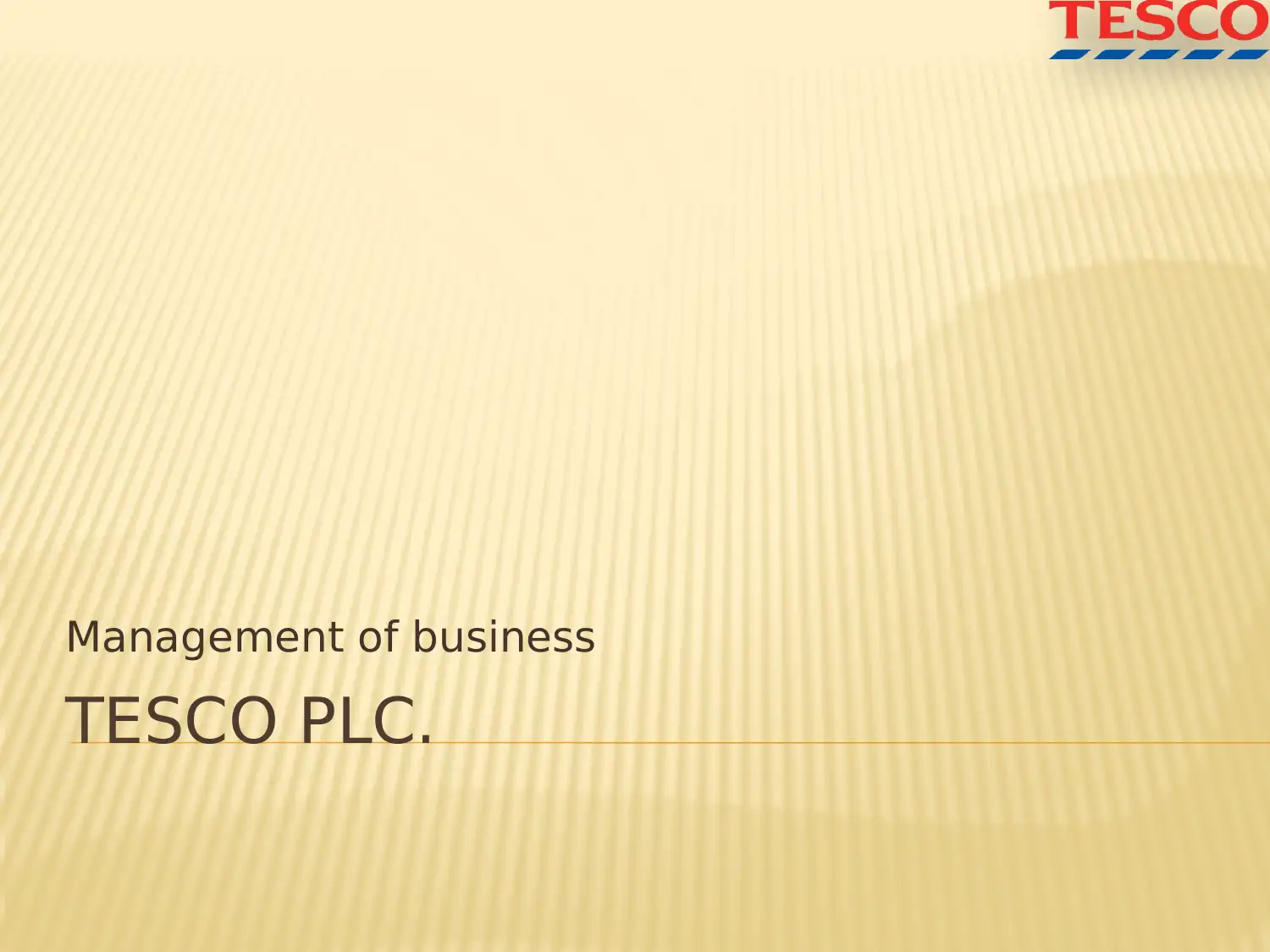
TESCO PLC.
Management of business
Management of business
Paraphrase This Document
Need a fresh take? Get an instant paraphrase of this document with our AI Paraphraser
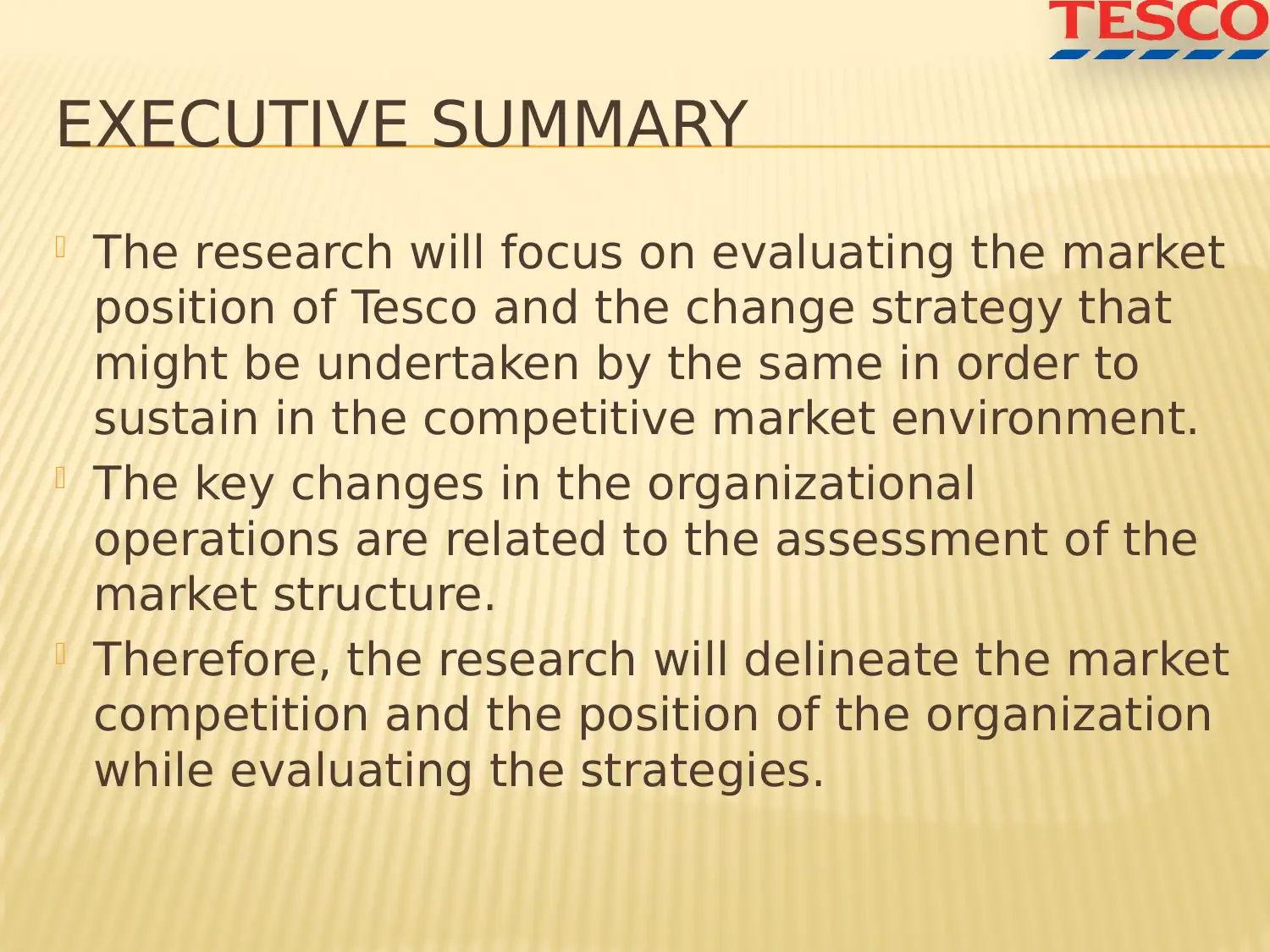
EXECUTIVE SUMMARY
The research will focus on evaluating the market
position of Tesco and the change strategy that
might be undertaken by the same in order to
sustain in the competitive market environment.
The key changes in the organizational
operations are related to the assessment of the
market structure.
Therefore, the research will delineate the market
competition and the position of the organization
while evaluating the strategies.
The research will focus on evaluating the market
position of Tesco and the change strategy that
might be undertaken by the same in order to
sustain in the competitive market environment.
The key changes in the organizational
operations are related to the assessment of the
market structure.
Therefore, the research will delineate the market
competition and the position of the organization
while evaluating the strategies.
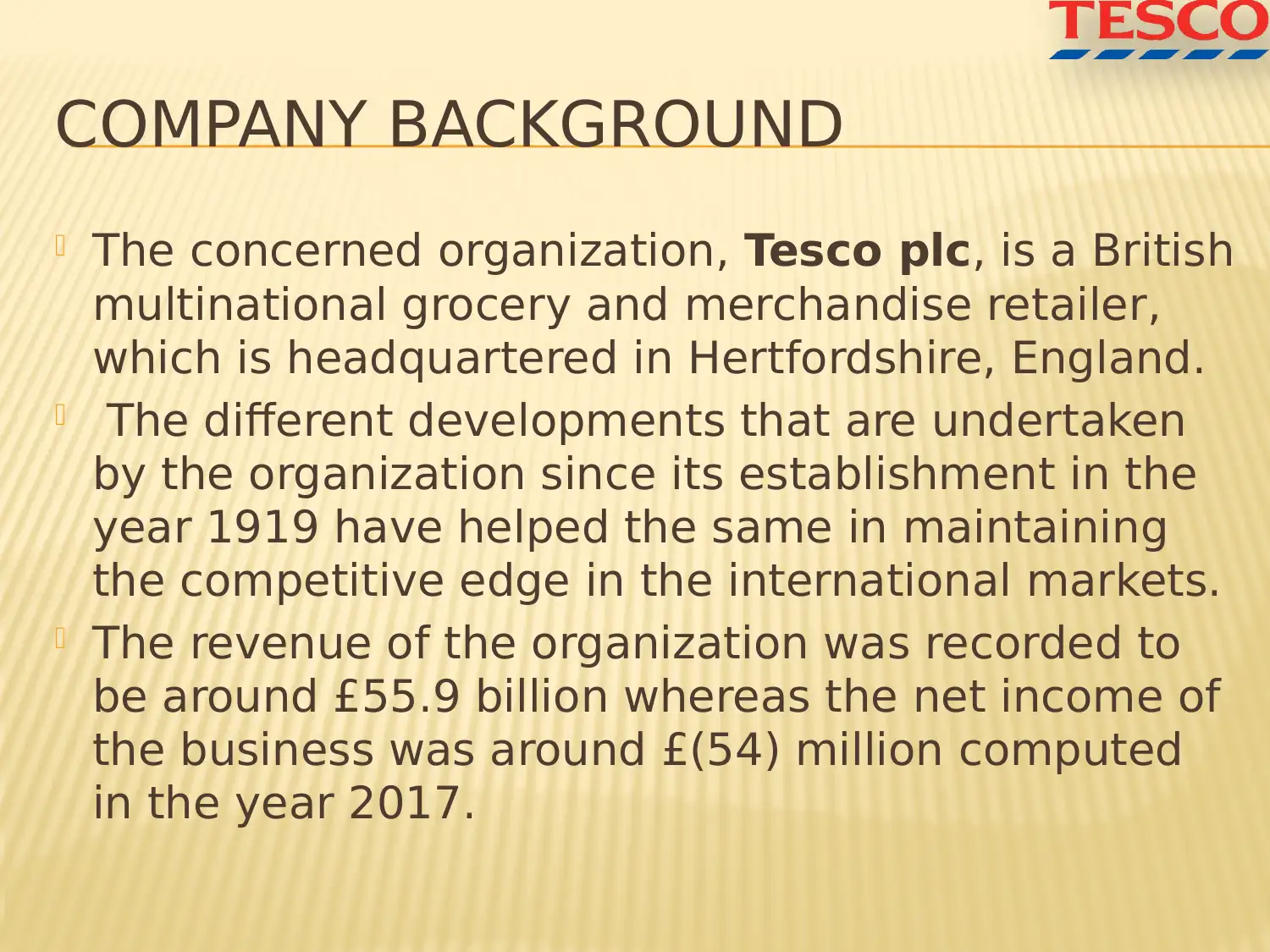
COMPANY BACKGROUND
The concerned organization, Tesco plc, is a British
multinational grocery and merchandise retailer,
which is headquartered in Hertfordshire, England.
The different developments that are undertaken
by the organization since its establishment in the
year 1919 have helped the same in maintaining
the competitive edge in the international markets.
The revenue of the organization was recorded to
be around £55.9 billion whereas the net income of
the business was around £(54) million computed
in the year 2017.
The concerned organization, Tesco plc, is a British
multinational grocery and merchandise retailer,
which is headquartered in Hertfordshire, England.
The different developments that are undertaken
by the organization since its establishment in the
year 1919 have helped the same in maintaining
the competitive edge in the international markets.
The revenue of the organization was recorded to
be around £55.9 billion whereas the net income of
the business was around £(54) million computed
in the year 2017.
⊘ This is a preview!⊘
Do you want full access?
Subscribe today to unlock all pages.

Trusted by 1+ million students worldwide
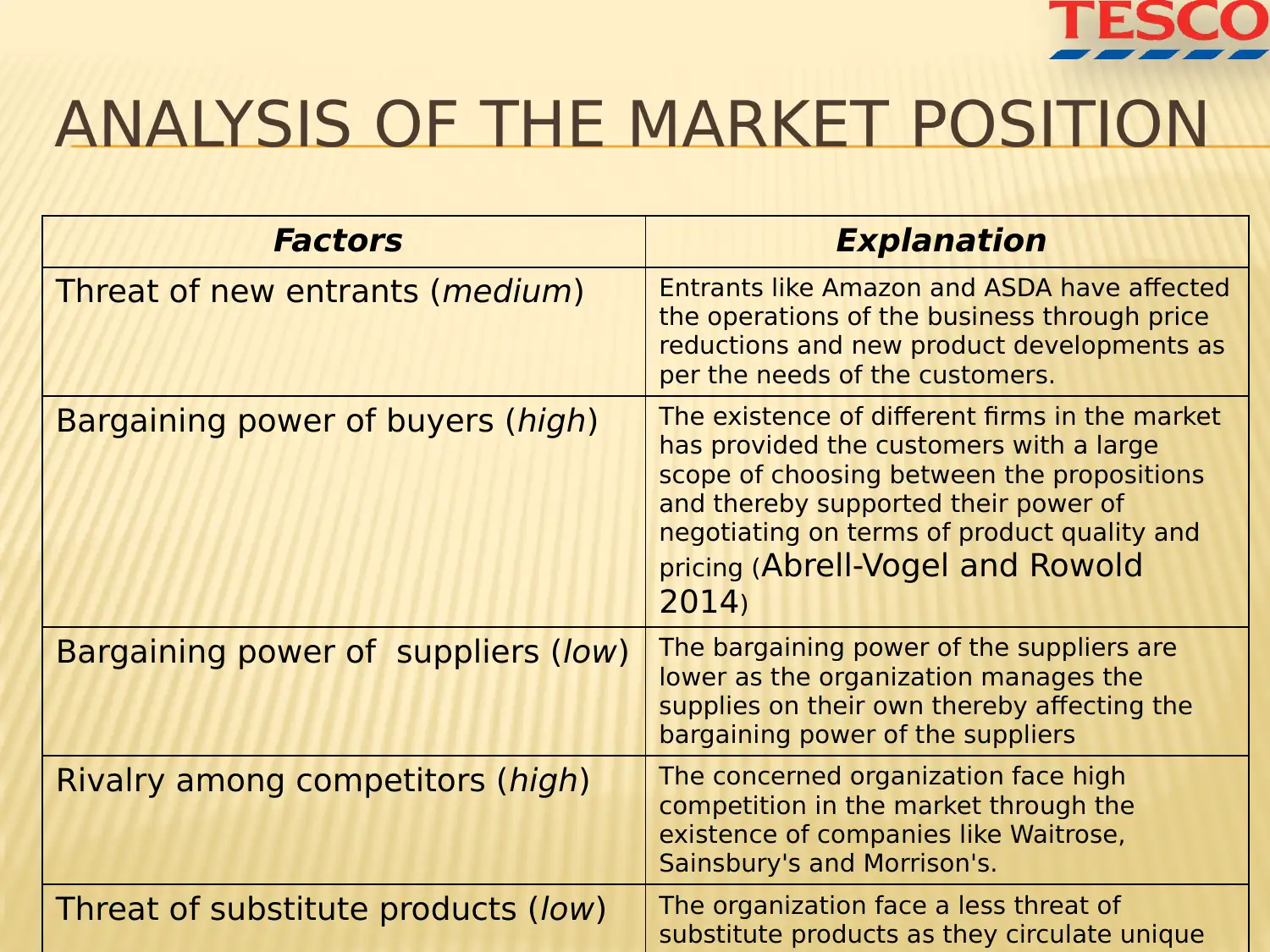
ANALYSIS OF THE MARKET POSITION
Factors Explanation
Threat of new entrants (medium) Entrants like Amazon and ASDA have affected
the operations of the business through price
reductions and new product developments as
per the needs of the customers.
Bargaining power of buyers (high) The existence of different firms in the market
has provided the customers with a large
scope of choosing between the propositions
and thereby supported their power of
negotiating on terms of product quality and
pricing (Abrell-Vogel and Rowold
2014)
Bargaining power of suppliers (low) The bargaining power of the suppliers are
lower as the organization manages the
supplies on their own thereby affecting the
bargaining power of the suppliers
Rivalry among competitors (high) The concerned organization face high
competition in the market through the
existence of companies like Waitrose,
Sainsbury's and Morrison's.
Threat of substitute products (low) The organization face a less threat of
substitute products as they circulate unique
Factors Explanation
Threat of new entrants (medium) Entrants like Amazon and ASDA have affected
the operations of the business through price
reductions and new product developments as
per the needs of the customers.
Bargaining power of buyers (high) The existence of different firms in the market
has provided the customers with a large
scope of choosing between the propositions
and thereby supported their power of
negotiating on terms of product quality and
pricing (Abrell-Vogel and Rowold
2014)
Bargaining power of suppliers (low) The bargaining power of the suppliers are
lower as the organization manages the
supplies on their own thereby affecting the
bargaining power of the suppliers
Rivalry among competitors (high) The concerned organization face high
competition in the market through the
existence of companies like Waitrose,
Sainsbury's and Morrison's.
Threat of substitute products (low) The organization face a less threat of
substitute products as they circulate unique
Paraphrase This Document
Need a fresh take? Get an instant paraphrase of this document with our AI Paraphraser
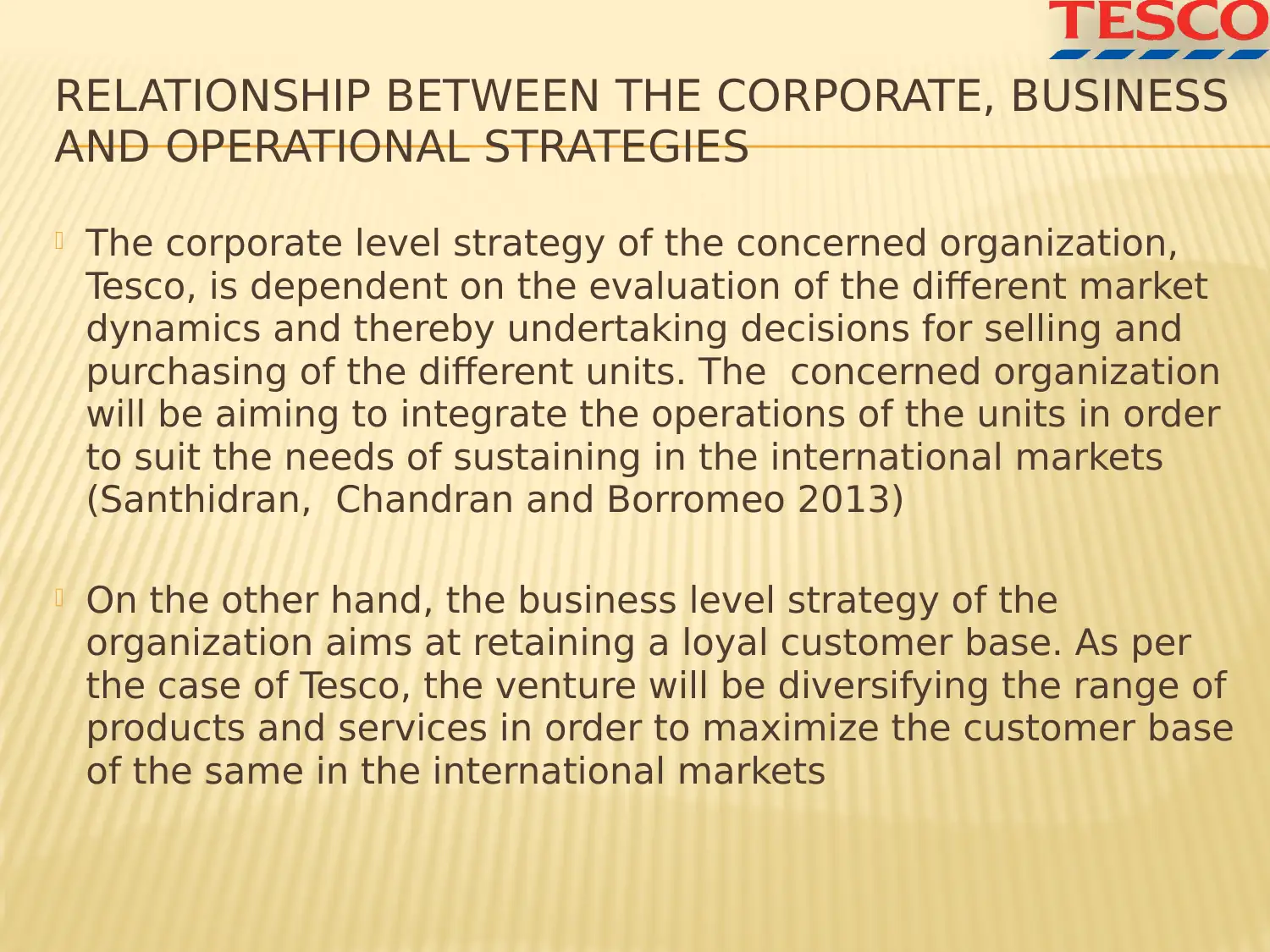
RELATIONSHIP BETWEEN THE CORPORATE, BUSINESS
AND OPERATIONAL STRATEGIES
The corporate level strategy of the concerned organization,
Tesco, is dependent on the evaluation of the different market
dynamics and thereby undertaking decisions for selling and
purchasing of the different units. The concerned organization
will be aiming to integrate the operations of the units in order
to suit the needs of sustaining in the international markets
(Santhidran, Chandran and Borromeo 2013)
On the other hand, the business level strategy of the
organization aims at retaining a loyal customer base. As per
the case of Tesco, the venture will be diversifying the range of
products and services in order to maximize the customer base
of the same in the international markets
AND OPERATIONAL STRATEGIES
The corporate level strategy of the concerned organization,
Tesco, is dependent on the evaluation of the different market
dynamics and thereby undertaking decisions for selling and
purchasing of the different units. The concerned organization
will be aiming to integrate the operations of the units in order
to suit the needs of sustaining in the international markets
(Santhidran, Chandran and Borromeo 2013)
On the other hand, the business level strategy of the
organization aims at retaining a loyal customer base. As per
the case of Tesco, the venture will be diversifying the range of
products and services in order to maximize the customer base
of the same in the international markets
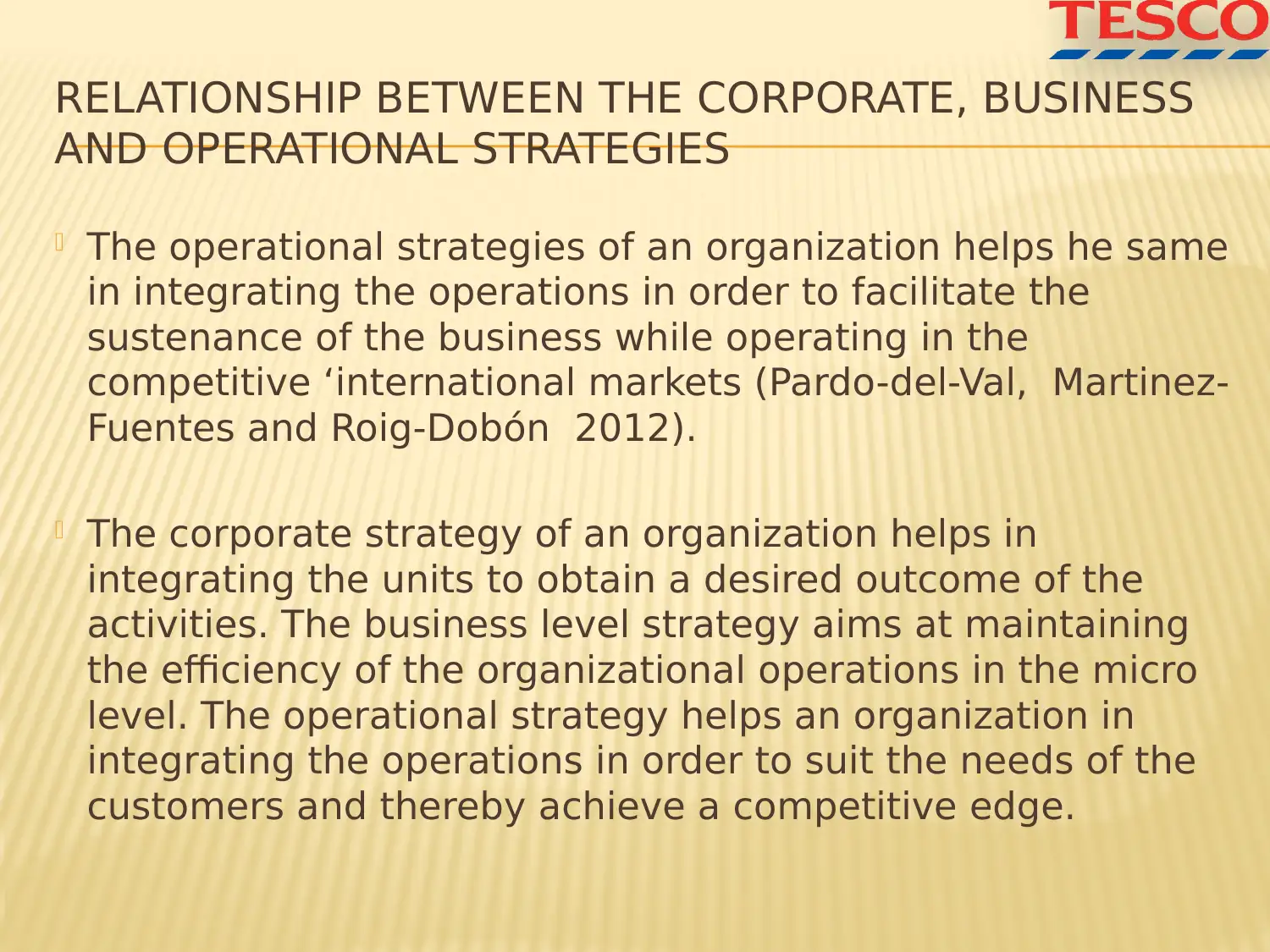
RELATIONSHIP BETWEEN THE CORPORATE, BUSINESS
AND OPERATIONAL STRATEGIES
The operational strategies of an organization helps he same
in integrating the operations in order to facilitate the
sustenance of the business while operating in the
competitive ‘international markets (Pardo-del-Val, Martinez-
Fuentes and Roig-Dobón 2012).
The corporate strategy of an organization helps in
integrating the units to obtain a desired outcome of the
activities. The business level strategy aims at maintaining
the efficiency of the organizational operations in the micro
level. The operational strategy helps an organization in
integrating the operations in order to suit the needs of the
customers and thereby achieve a competitive edge.
AND OPERATIONAL STRATEGIES
The operational strategies of an organization helps he same
in integrating the operations in order to facilitate the
sustenance of the business while operating in the
competitive ‘international markets (Pardo-del-Val, Martinez-
Fuentes and Roig-Dobón 2012).
The corporate strategy of an organization helps in
integrating the units to obtain a desired outcome of the
activities. The business level strategy aims at maintaining
the efficiency of the organizational operations in the micro
level. The operational strategy helps an organization in
integrating the operations in order to suit the needs of the
customers and thereby achieve a competitive edge.
⊘ This is a preview!⊘
Do you want full access?
Subscribe today to unlock all pages.

Trusted by 1+ million students worldwide
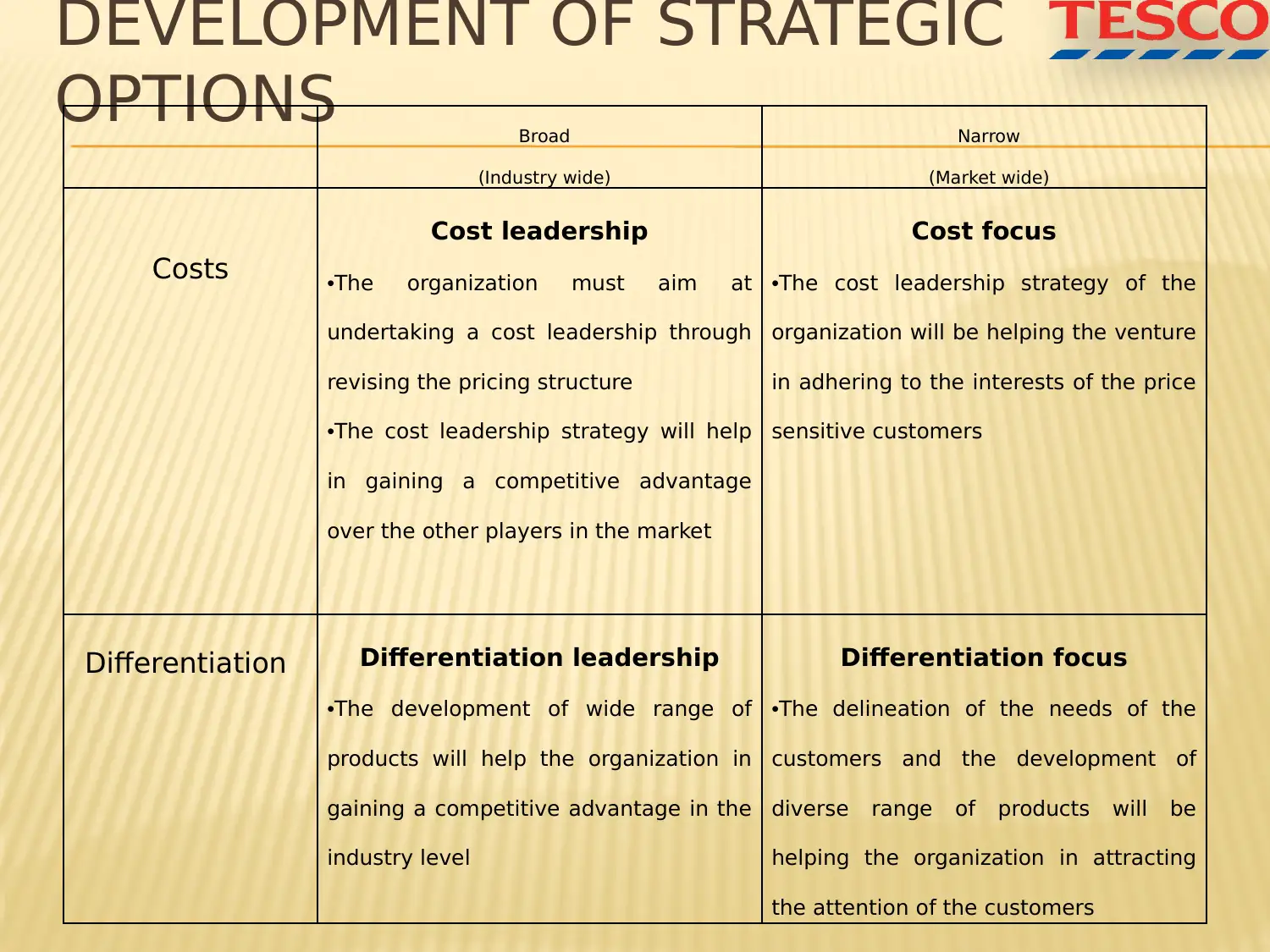
DEVELOPMENT OF STRATEGIC
OPTIONS Broad
(Industry wide)
Narrow
(Market wide)
Costs
Cost leadership
•The organization must aim at
undertaking a cost leadership through
revising the pricing structure
•The cost leadership strategy will help
in gaining a competitive advantage
over the other players in the market
Cost focus
•The cost leadership strategy of the
organization will be helping the venture
in adhering to the interests of the price
sensitive customers
Differentiation Differentiation leadership
•The development of wide range of
products will help the organization in
gaining a competitive advantage in the
industry level
Differentiation focus
•The delineation of the needs of the
customers and the development of
diverse range of products will be
helping the organization in attracting
the attention of the customers
OPTIONS Broad
(Industry wide)
Narrow
(Market wide)
Costs
Cost leadership
•The organization must aim at
undertaking a cost leadership through
revising the pricing structure
•The cost leadership strategy will help
in gaining a competitive advantage
over the other players in the market
Cost focus
•The cost leadership strategy of the
organization will be helping the venture
in adhering to the interests of the price
sensitive customers
Differentiation Differentiation leadership
•The development of wide range of
products will help the organization in
gaining a competitive advantage in the
industry level
Differentiation focus
•The delineation of the needs of the
customers and the development of
diverse range of products will be
helping the organization in attracting
the attention of the customers
Paraphrase This Document
Need a fresh take? Get an instant paraphrase of this document with our AI Paraphraser
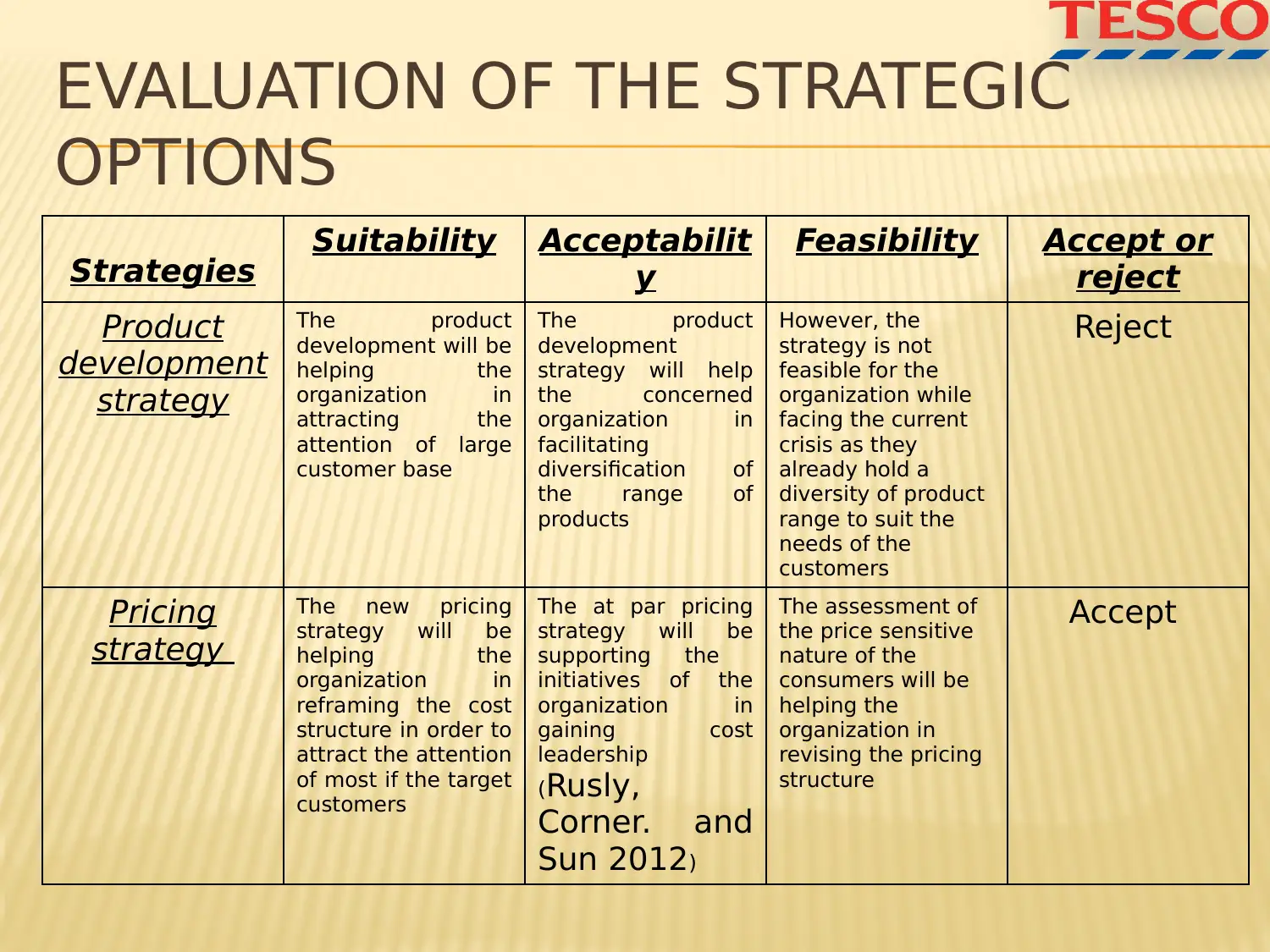
EVALUATION OF THE STRATEGIC
OPTIONS
Strategies Suitability Acceptabilit
y
Feasibility Accept or
reject
Product
development
strategy
The product
development will be
helping the
organization in
attracting the
attention of large
customer base
The product
development
strategy will help
the concerned
organization in
facilitating
diversification of
the range of
products
However, the
strategy is not
feasible for the
organization while
facing the current
crisis as they
already hold a
diversity of product
range to suit the
needs of the
customers
Reject
Pricing
strategy
The new pricing
strategy will be
helping the
organization in
reframing the cost
structure in order to
attract the attention
of most if the target
customers
The at par pricing
strategy will be
supporting the
initiatives of the
organization in
gaining cost
leadership
(Rusly,
Corner. and
Sun 2012)
The assessment of
the price sensitive
nature of the
consumers will be
helping the
organization in
revising the pricing
structure
Accept
OPTIONS
Strategies Suitability Acceptabilit
y
Feasibility Accept or
reject
Product
development
strategy
The product
development will be
helping the
organization in
attracting the
attention of large
customer base
The product
development
strategy will help
the concerned
organization in
facilitating
diversification of
the range of
products
However, the
strategy is not
feasible for the
organization while
facing the current
crisis as they
already hold a
diversity of product
range to suit the
needs of the
customers
Reject
Pricing
strategy
The new pricing
strategy will be
helping the
organization in
reframing the cost
structure in order to
attract the attention
of most if the target
customers
The at par pricing
strategy will be
supporting the
initiatives of the
organization in
gaining cost
leadership
(Rusly,
Corner. and
Sun 2012)
The assessment of
the price sensitive
nature of the
consumers will be
helping the
organization in
revising the pricing
structure
Accept
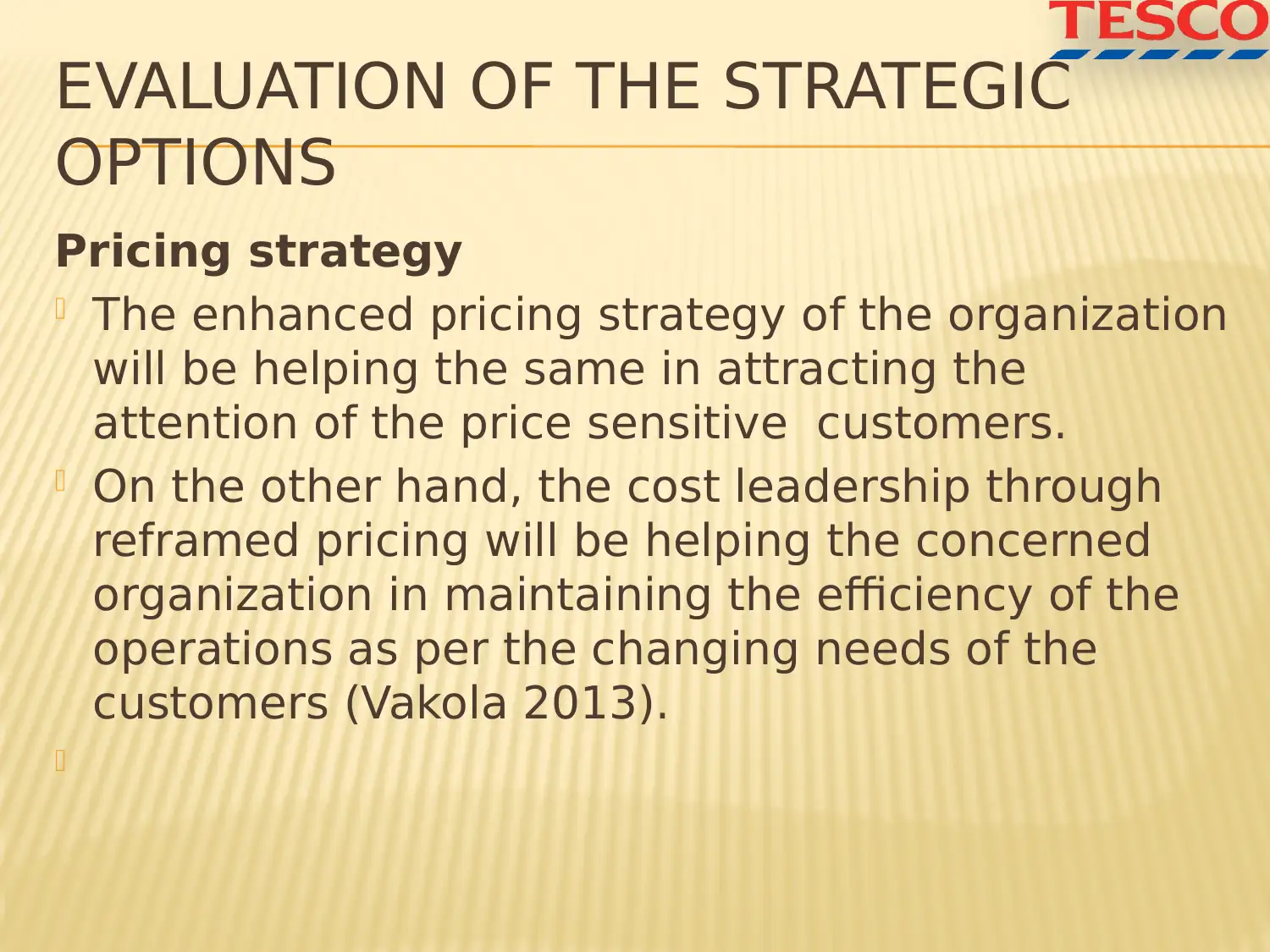
EVALUATION OF THE STRATEGIC
OPTIONS
Pricing strategy
The enhanced pricing strategy of the organization
will be helping the same in attracting the
attention of the price sensitive customers.
On the other hand, the cost leadership through
reframed pricing will be helping the concerned
organization in maintaining the efficiency of the
operations as per the changing needs of the
customers (Vakola 2013).
OPTIONS
Pricing strategy
The enhanced pricing strategy of the organization
will be helping the same in attracting the
attention of the price sensitive customers.
On the other hand, the cost leadership through
reframed pricing will be helping the concerned
organization in maintaining the efficiency of the
operations as per the changing needs of the
customers (Vakola 2013).
⊘ This is a preview!⊘
Do you want full access?
Subscribe today to unlock all pages.

Trusted by 1+ million students worldwide
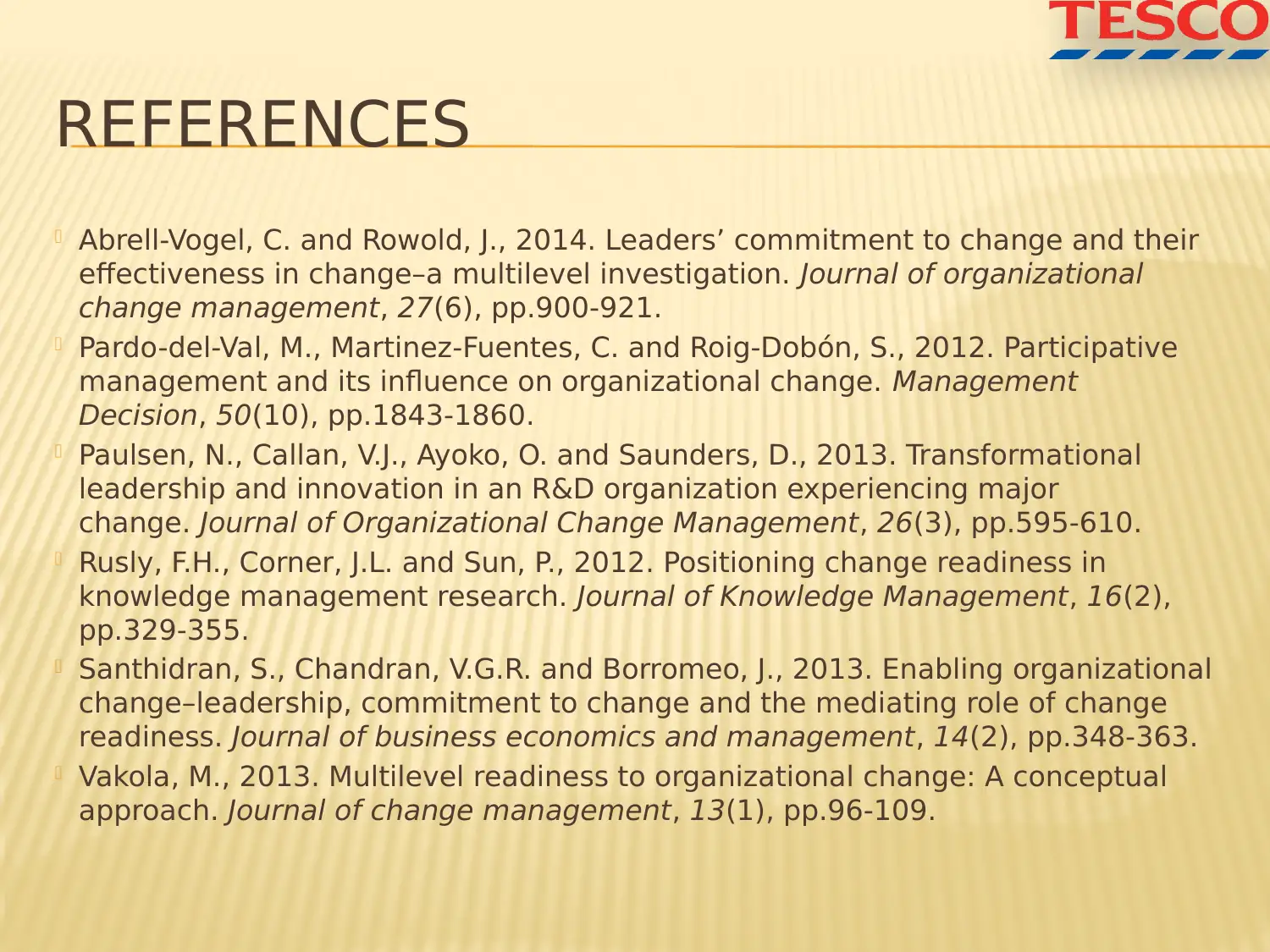
REFERENCES
Abrell-Vogel, C. and Rowold, J., 2014. Leaders’ commitment to change and their
effectiveness in change–a multilevel investigation. Journal of organizational
change management, 27(6), pp.900-921.
Pardo-del-Val, M., Martinez-Fuentes, C. and Roig-Dobón, S., 2012. Participative
management and its influence on organizational change. Management
Decision, 50(10), pp.1843-1860.
Paulsen, N., Callan, V.J., Ayoko, O. and Saunders, D., 2013. Transformational
leadership and innovation in an R&D organization experiencing major
change. Journal of Organizational Change Management, 26(3), pp.595-610.
Rusly, F.H., Corner, J.L. and Sun, P., 2012. Positioning change readiness in
knowledge management research. Journal of Knowledge Management, 16(2),
pp.329-355.
Santhidran, S., Chandran, V.G.R. and Borromeo, J., 2013. Enabling organizational
change–leadership, commitment to change and the mediating role of change
readiness. Journal of business economics and management, 14(2), pp.348-363.
Vakola, M., 2013. Multilevel readiness to organizational change: A conceptual
approach. Journal of change management, 13(1), pp.96-109.
Abrell-Vogel, C. and Rowold, J., 2014. Leaders’ commitment to change and their
effectiveness in change–a multilevel investigation. Journal of organizational
change management, 27(6), pp.900-921.
Pardo-del-Val, M., Martinez-Fuentes, C. and Roig-Dobón, S., 2012. Participative
management and its influence on organizational change. Management
Decision, 50(10), pp.1843-1860.
Paulsen, N., Callan, V.J., Ayoko, O. and Saunders, D., 2013. Transformational
leadership and innovation in an R&D organization experiencing major
change. Journal of Organizational Change Management, 26(3), pp.595-610.
Rusly, F.H., Corner, J.L. and Sun, P., 2012. Positioning change readiness in
knowledge management research. Journal of Knowledge Management, 16(2),
pp.329-355.
Santhidran, S., Chandran, V.G.R. and Borromeo, J., 2013. Enabling organizational
change–leadership, commitment to change and the mediating role of change
readiness. Journal of business economics and management, 14(2), pp.348-363.
Vakola, M., 2013. Multilevel readiness to organizational change: A conceptual
approach. Journal of change management, 13(1), pp.96-109.
Paraphrase This Document
Need a fresh take? Get an instant paraphrase of this document with our AI Paraphraser

1 out of 11
Related Documents
Your All-in-One AI-Powered Toolkit for Academic Success.
+13062052269
info@desklib.com
Available 24*7 on WhatsApp / Email
![[object Object]](/_next/static/media/star-bottom.7253800d.svg)
Unlock your academic potential
Copyright © 2020–2025 A2Z Services. All Rights Reserved. Developed and managed by ZUCOL.




